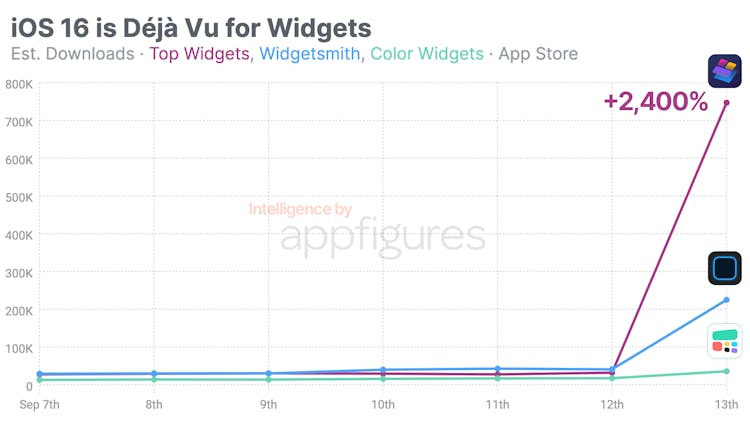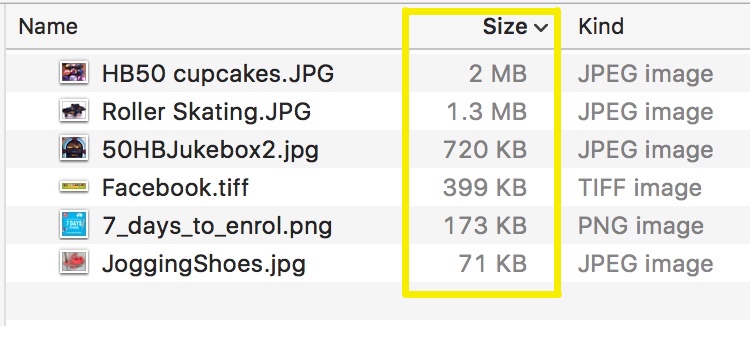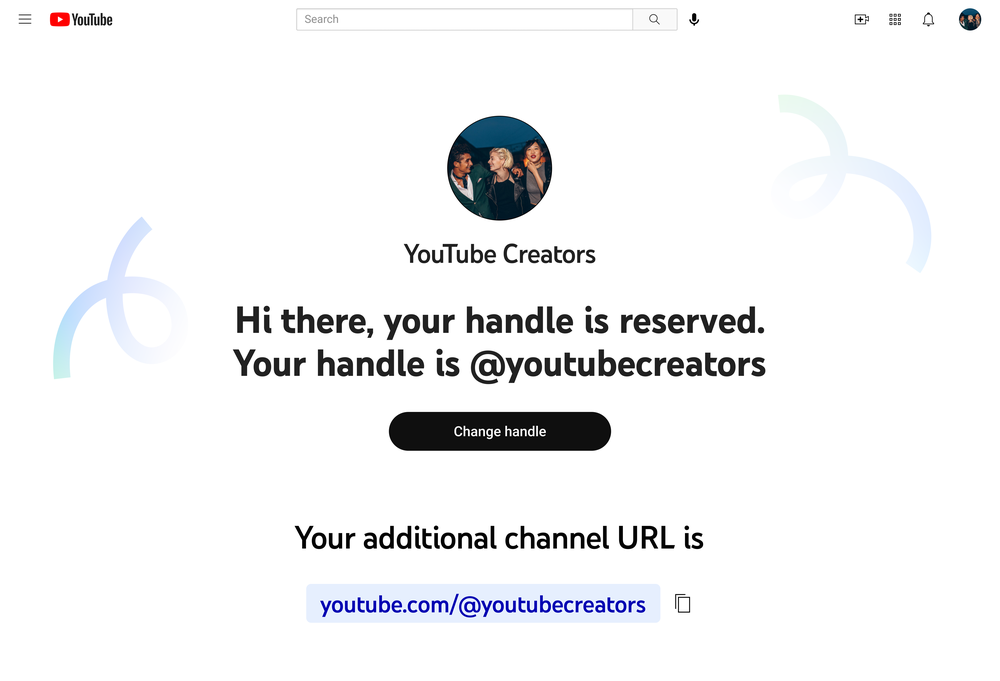Small technology changes create profitable bootstrapped products
How do small technology changes create profitable bootstrapped products? Let's start with an example of such a change:
Example 1: Apple Lock Screen Widgets
The change:: When Apple released iOS 16 on September 12 this year, one of the biggest new features were lock screen widgets.
The opportunity: This change propelled widgets to the top of the App Store According to AppFigures, with some of the most popular widget apps seeing a 169%-2400% increase of daily downloads.

This change also spurred a new wave of lock screen widget apps and tech publications were more than happy to give free press to many of them.
Look out for: When new platforms (like Apple, Facebook) add particular features, that usually creates opportunities for countless small projects to be created around those features.
Example 2: Cloudflare R2
Wanna create an image hosting website? Sure, you can host all images on a service like Amazon S3, but be prepared to pay $0.09 for each GB transferred.
What if a user uploads an HD image that goes viral? An average image can be as big as 2MB (or more):

The last thing you want to do with a side project is monitor for unexpected costs.
Let's say gets viral and gets 100,000 requests. That's 200,000 megabytes or 200 GB. That's ($0.09 * 200 =) $18 just for a single image. Ouch.
The change: This was a problem until Cloudflare R2 appeared. On September 28th, 2021, Cloudflare announced an S3 competitor (called Amazon R2) where you effectively pay $0 for transfers and only pay for storage.
This caused Amazon to respond and offer the first 100GB of bandwidth for free. But again, after that you still pay $0.09. Still not ideal for a bootstrapped project or a side business which can take off.
On September 21st, 2021, Cloudflare made R2 available to everyone. The only major cost is $0.015 per GB stored (and some minor costs per 1 million request). The rest is free.

The opportunity: This change opened up a whole lot of opportunities for indie hackers like me and you to create products that previously we were simply too afraid to create:
- An image hosting service
- Backup creation/storage tools
- Anything related to file uploads where you'd expect high bandwidth (think: Dropbox, big document sharing services, etc.)
The nice thing about all this is that we could be predictable around the pricing. We could create pricing tiers where we charge per-storage (like all big providers do) not not per-bandwidth.
Look out for:" Once in a while, big PaaS providers release an update that makes it possible to build SaaS applications that weren't possible before.
Example 3: Generative AI development
The change: Here I'm talking about GPT-3, DALL-E 2 (and competitors like Stable Diffusion and Midjourney) and upcoming text-to-video projects like Google's X and Facebook's Y.
I published a post last week on how DALL-E 2 (and its competitors) are already disrupting 15 different industries. This just less than a year after its initial release. Here's the current growth of one website which is built on top of a DALL-E 2 competitor (called Stable Diffusion):

GPT-3 has already started to disrupt industries like novel writing, writing marketing copy and, well, eliminating the writer's block.
Look out for: AI is on a fast track to replace many aspects of many professions. Those changes will come as APIs and the people who'll win will probably be creative founders who adopted that API around a market need.
Technology changes like these happen all the time
- A big plaform makes a change that opens up a new wave of apps (Apple with iOS 16)
- A developer platform creates something that makes it affordable to create something that previously was very expensive to build (Cloudflare RS).
- Someone creates an AI platform that enables a whole range of things that previously weren't possible (Open AI with GPT-3/DALL-E 2).
So the important question is:
How do you identify those changes first ?
There are several things you can do:
-
Keep an eye on major platforms for new features. (platforms like Meta and Google have newsroom where they post their latest features.)
-
Alternatively , you can follow people who monitor the big players (like Stacked Marketer and Matt Navarra).
-
Subscribe to RSS feeds of blogs that power the majority of today's web (Cloudflare has a blog, AWS has a blog too). Hacker News features the most important changes regularly on their website.
-
Subscribe to my newsletter (a shameless plug :)) ). I cover such opportunities regularly:
YouTube handles = the next lucrative bootstrapped opportunity?
Minor changes can also create potentially lucrative bootstrapped ideas.
One such recent change is YouTube adding handles. In other news, they've finally introduced usernames::

If you've been in the domaining industry and/or social media for long enough, you may recognize the opportunity here. Premium domain names sell for thousands each day. So do Instagram handles.
I can see indie hackers creating small tools in the future that will:
- Enable YouTube creators to easily find good available handles for their channel
- Someone making a tool that will grab the premium handles and then resell them. Or create a marketplace for people to buy/sell handles.
- A tool that will watch to see if your desired handle is "released" and becomes available again.
When you first read about this YouTube change, you probably thought to yourself, "Meh, nothing special." However, if you think a little harder, you will see a lot of opportunities.
This is just one such change. There are tens of different changes like this happening every week.
The opportunites is here. You just need to go out and grab code them.
 Indie hackers selling to indie hackers?
Indie hackers selling to indie hackers?

Great post! Paul Graham talked about it in "how to get startup ideas"
http://paulgraham.com/startupideas.html
"If you're at the leading edge of a field that's changing fast, when you have a hunch that something is worth doing, you're more likely to be right."
Of course, "leading edge" can vary . If you want to create a unicorn, maybe you want to be in a PhD research lab. But if you want to create a micro-saas, often times just staying on top of new APIs (e.g. OpenAI, Notion, etc) is key, so you can "piggyback" off the big guys.
While web3 is in a bit of a winter, I think it's worth checking out someone like Vitalik Buterin's blog. A lot of successful stuff in that space was started by a blog posts of his (e.g. Uniswap was made by a new grad who read Vitalik write about decentralized market makers and now has billions in volume).
Similarly, genius Linus Torvalds invented Git and lesser geniues found huge success with Github and Gitlab.
I also think no-code platforms and e-commerce platforms like Shopify are worth keeping an eye on.
My thinking is, let the giga-brains like Vitalik and Linus come up with the massive platforms, and us mortals can think of small ways to repackage it in simpler products.
Interesting, haven't thought of this. Yeah, following mega-influencers like Vitalik is also something worth doing.
Great article, nice examples, the youtube handles one is particularly interesting. As you said you have to give second thought on these kind of news to look for an opportunity in them.
Thanks for sharing this type of informative article. I have learned some right stuff here. I really like your articles.
No-code is the start of code. 😄
Great! That's what I wanted for a long time. Thanks
Love the concept Darko. what you working on?
Hey there. Great post!
I liked the fact that your explanation were illustrated with images. Keep up the good work ;)
The youtube handles marketplace is very interesting...
no conocia estos cambios, gracias!
Hmm impressive!
Cloudflare wasn't the first to release an "unlimited bandwidth-only-pay-for-storage" S3 alternative, but they were deff the most reputable one.
I read Hacker News and know about most of these changes. How do you translate these changes into marketing opportunities though?
I saw most of these changes on HackerNews. Pretty interesting.
This comment was deleted 2 years ago.
This comment was deleted 2 years ago.
This comment was deleted 2 years ago.